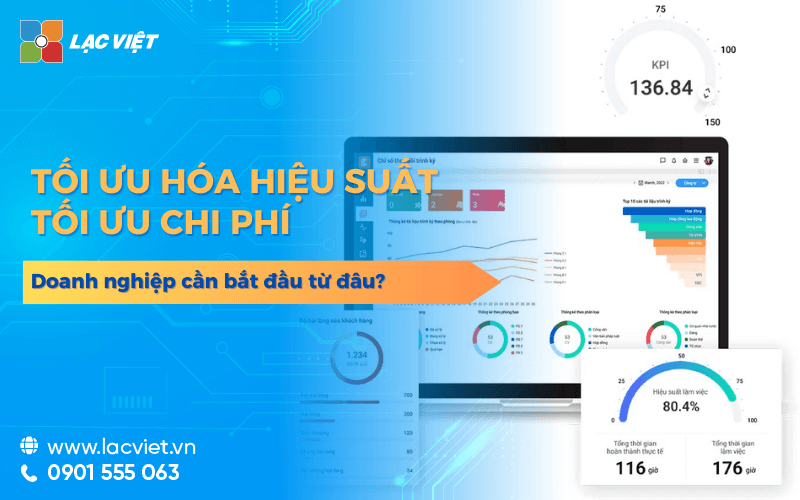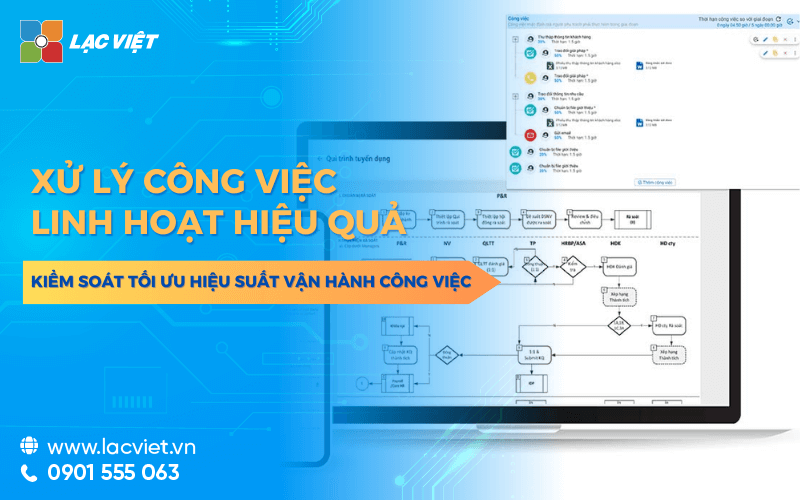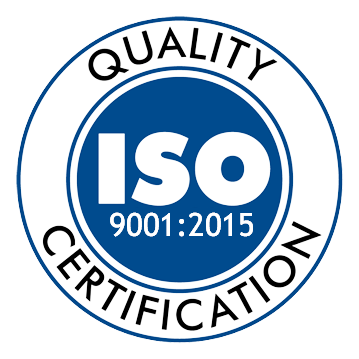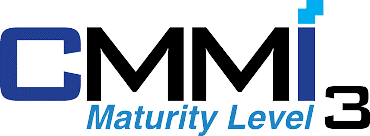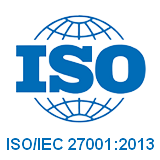Reviews the work efficiency is the operation to be performed periodically by the audit forms, according to which managers and employees jointly identify, evaluate, feedback on the level of completion of work of the employee in comparison with the objectives. This process includes not only the measurement of the final result but also consider the skills, attitude, and effort of employees in the work process.
Formula reviews work efficiency as follows: Efficiency = work results/goals
Construction of the evaluation method is activity that any business needs to perform to determine the performance of the whole business. So where is the assessment method used the most current? Whether the methods that businesses are taking can truly assess the entire efficiency of the operation in business? The same Lac Viet Computing find out details in this article.

1. The importance of assessment activities work efficiency
1.1 Improve work performance for team
Evaluate the effectiveness work to help clearly define the objectives of individuals and groups, from which boost work performance. When employees understand the requirements, expectations from management, they can adjust the working strategy suitable to achieve objectives. According to a study of Gallup in the year 2022, the company may process reviews regular performance has improved by 21% in productivity; 22% in strengthening profits than businesses do not have a similar process.

A practical example is at General Electric (GE), the company has moved from model annual reviews to the continuous assessment (ongoing feedback). After making changes, GE reported pronounced increase of the performance of the work team, with 77% of employees feel better assistance to complete work objectives.
1.2 flaw detection on the skills and competencies to overcome
Reviews work efficiency are important tools to identify the weak points that need improvement. Through the evaluation process, businesses can detect the missing skill or those areas in which employees have difficulty. This not only helps businesses to shape the training program fit that also helps employees understand the needs of its development.
According to the report of SHRM (Society for Human Resource Management)74% of companies have a review process, good performance has implemented the training program promptly after receiving feedback from the evaluation process. An example is Microsoft, when the switch model reviews, they have increased by 15% the number of employees participating in the training course aimed at overcoming the flaw skills.
1.3 enhance the satisfaction of employees
When employees are rated fair, get feedback, constructive, they feel valued and have the opportunity to develop in the organization. Helps to strengthen the cohesion and loyalty of employees to the business. According to a survey from Glint in 2021, the employees feel is a fair assessment have the ability to stick with companies that are higher than 2.7 times compared with those who do not receive positive feedback.
For example, at company Deloitte, after their conversion system, employee evaluation, integrating the fast response rate of employee satisfaction has increased 17%. This suggests that the evaluation of work efficiency, play an important role in retaining talent.

1.4 Support the construction of the roadmap development
Assessment activities not only help businesses improve performance but also provides a clear roadmap for the personal development of employees. When employees know the strengths and weaknesses of yourself through the reviews, they can build development plans long-term to achieve personal goals, even advance in your career.
According to a report from LinkedIn Learning, 94% of employees said they would stick with the company long term if there are growth opportunities for advancement. At Salesforce, the company has set up a review process to clearly define the roadmap advance for each individual. As a result, they had decreased by 12% the percentage of employees who leave voluntarily within two years after the application of this system.
2. Criteria for evaluating work performance need
To evaluate the effectiveness of work in a comprehensive manner to be effective, businesses need to build the rating criteria based on 2 factors, quantitative and qualitative. These criteria not only help determine the level of completion of the work, but also reflect the competencies, attitudes, capabilities, development of staff.
2.1 quality of work
Quality of work is the most important criteria in the evaluation of efficiency. This is a key factor determining the level of precision, perfection, effectiveness of the assigned tasks.
- How to measure: quality of work is often measured based on the level of compliance with the initial request, feedback from stakeholders (customer, internal, external) and industry standards related.
- For example, A software engineer can be evaluated based on the number of error (bug) in the source code after the completion of a project or the ability to optimize the performance of the software.
2.2 workload
Workload measure the number of tasks that an employee can complete in a specific time period. This criterion helps to assess the ability of time management, the ability to divide the work and individual performance.
- How to measure: Typically be monitored through the number of missions completed, the project is done or the product is produced in a specified time interval.
- For example, A business can be assessed through the number of sales calls, or the number of contracts signed per month.
2.3 active, creative
This criterion is assessed ability to solve problems, propose new solutions, developing innovative ideas to improve the workflow or to create products, new services for the company.
- How to measure: initiative can be measured through the staff put out innovative solutions in work, the proposed process improvements or solve problems that arise without the direction details from management.
- For example, In the field of marketing, staff can be assessed through a number of quality, innovative campaigns in which they propose to deploy successfully.
2.4 the Possibility of cooperation and team work
In a work environment, modern interoperability between individuals are important factors enhances the efficiency of the whole team. This criterion measures the level of communication, coordination ability, and team spirit of the employees in the joint project.
- How to measure: can be evaluated based on feedback from colleagues, the ability to complete the task group, how to handle the conflict in work.
- For example: A member in the group project can be evaluated through the level of contribution to the overall success of the project, the ability to coordination with the other members.
According to Gallup, the group has good cooperation with higher yield by 17% and the ability to attain high goals more than 21% compared with the group that did not have an effective partnership.
2.5 Compliance with the discipline work time
This criterion focuses on the assessment of right now, the ability to comply with the work plan, observance of internal regulations of the company. Here are important factors to ensure discipline in the work among the employees.
- How to measure: Compliance time can be assessed through the proportion of complete tasks on time, the level of compliance workflow, the number of times a disciplinary offense related to working time.
- For example: An employee delivery can be assessed through the proportion of on-time delivery, satisfaction level of customers about discipline in work.
According to research from Institute of Management Studies, the company has a policy to manage tight time staff was reduced by 25% the number of backlog, 20% increase in ability to complete the project on time.
2.6 Attitude and spirit work
Attitude to work is the elements soft, but has a huge impact on the environment work culture of the company. An employee with a positive attitude can inspire motivation for the whole team, at the same time improve the relationship between the members of the company.
- How to measure: mental Attitude, work can be measured through feedback from colleagues, management, customers, often including enthusiasm, commitment to work, ability to work under pressure.
- For example: A staff of customer care can be evaluated through customer feedback, mental support, the ability to solve problems in a friendly, professional.
A survey of the Society for Human Resource Management showed that 85% of companies have a culture spiritual encouragement positive work from the staff have level mounted higher, leading to job performance increased by 10% compared with other companies.
4. Review process efficient work
A process assessment standard will help the business to properly evaluate the capacity of staff, should be built based on the specific steps to ensure transparency, fairness, thorough.
Process efficiency rating STANDARD work will include the following steps:
- Step 1: Determine the target of evaluation
- Step 2:collect data and assessment information
- Step 3: Proceed with evaluating the effectiveness of work staff
- Step 4: feedback and discussion
- Step 5: set up action plans to improve
- Step 6: monitor and adjust
Step 1: Determine the target of evaluation
The first important step is the manager and employee should discuss together, set specific goals that employees need to achieve in assessment.
The goal should be clear, measurable, made in accordance with the strategy of the business. Model SMART (Specific – specific, Measurable – measurable, Achievable – viable, Relevant – relevant, and Time-bound – for a limited time) is a common method to set goals.
For example, A business can set a goal to increase sales 20% more in the next 6 months or signing is at least 10 new contracts every quarter.
Step 2:collect data and assessment information
This step includes obtaining the information, data, data related to the work of employees throughout the states reviews. Information can be obtained from many sources such as the work report weekly/monthly results from the system software, project management, feedback customers by email or online survey, feedback from members of the group working together.
For example, For an employee, customer care, data may be collected from the percentage of complaints resolved successfully, the level of customer satisfaction (Customer Satisfaction Score – CSAT), direct feedback from customers.
Step 3: Proceed with evaluating the effectiveness of work staff
After collecting data, the next step is to conduct the reviews between managers and employees. The assessment process should take place in a transparent way, based on the criteria defined previously. The assessment should focus on the actual data, avoid giving out review subjective or emotional.
The types of reviews:
- 360 degree assessment: including remarks from many sources, including peers, superiors, even as the customer to have a comprehensive view of the work efficiency of employees.
- Reviews from the direct superior: This is a form rating the most popular, where direct management put out a review and assessment of work performance of employees.
For example, At Google, 360 degree assessment is usually applied, which allows employees to receive feedback from many stakeholders, including colleagues and subordinates, help them have a multi-dimensional view of performance of work.
Step 4: feedback and discussion
This is an important stage to managers to provide specific feedback to staff about the strengths, weaknesses, and what aspects need improvement. The discussion need constructive, with the goal of not only reviews, but also helps employees better understand how the standard requires work.
Feedback:
- Feedback according to the model Sandwich: Response start by emphasizing strengths, then mention the points that need improvement, and ends with the words encourage and inspire.
- Feedback according to the model STAR (Situation – Task – Action – Result): feedback based on realistic situations that employees have gone through, which helps to clarify the problem of providing solutions.
For example: A marketing management can provide feedback on how the employee organization of advertising campaigns, including the successful campaign and the campaign needs to improve in the future.
Step 5: set up action plans to improve
Based on the results of the assessment feedback from managers, a plan to improve the performance should be established. This plan consists of specific steps that employees need to follow to overcome weaknesses, develop strengths. Plans should be formulated clearly feasible, accompanied by criteria specific measurement to assess progress in the future.
Important factors:
- Ensure employees understand the new goals and ways to achieve.
- Lay out the specific timelines to assess the progress.
For example, A salesperson can planning improve the ability to communicate via telephone by participating in the training course selling skills over the phone, perform at least 50 calls per week within 3 months.
Step 6: monitor and adjust
Tracking progress after the evaluation is the last step but not the least important part. Managers need to regularly check the progress of staff to assist when needed. Adjust the plan objectives if there is a change in working conditions or work requirements.
The manner of execution:
- The monitor periodically (monthly or quarterly) to check the progress made in the improvement plan.
- Re-evaluate work performance and adjustment of action plan if necessary.
For example, At Microsoft, managers often have meetings every month to re-evaluate the progress of the employees based on the plan of action was proposed, from which promptly adjust the goal or extra support if you get stuck.
To encourage employees to develop performance work, the rewards or form of recognition for personal achievement that can be implemented after employees reach or pass the goal proposed. The recognition of achievement not only help to raise the spirit but also promotes loyalty and employee engagement with business. For example: Staff outstanding achievement can be rewarded by the financial rewards, opportunities for advancement, or the form of recognition of the other as the title of “employee of the month.”
4. The method of evaluating work performance most popular
Here are 5 methods to assess work performance is more business most applicable:
- Assessment methods KPI
- Methods of evaluation by objectives MBO
- Method BSC (balanced scorecard)
- Method 360 degree assessment
- Methods of assessment BARS
4.1 Quantitative methods (KPIs)
KPIs (Key Performance Indicators) is the quantitative indicators to measure the performance of the employee or team. This method is based on the goals, specific, clear and measurable. For example, a business can be assessed through indicators in monthly revenue, while staff of customer care can be measured through the number of customer request is successfully processed.
- Determine the index of KPIS: management and employees together determine the performance metrics important, aligned with target work.
- Set level standards: Determine the level of standard for each KPI.
- Collect, track data: Use the tools to collect and monitor data related to the KPI.
- Reviews – feedback: evaluate the performance based on the results of the KPI, provide feedback to staff.

Advantages:
- Reviews clear objective, easy to measure
- Can compare between the states or with different groups.
- Encourage employees to navigate to the specific objectives, help them focus on the important tasks.
Cons:
- KPIs can be tied down in the numbers and do not fully reflect other values such as creativity, teamwork.
- If you only focus on KPIs, employees can skip the factors other software, or even attempted fraud to hit targets.
Practical application: A report from Harvard Business Review turns out that, in the company apply KPIs as a core part of the system evaluation, 47% perceived the level of completion of higher goals after applying this method. Coca-Cola is one of those businesses use KPIs to evaluate employees according to the criteria of quantitative specific, such as the number of products sold and the speed of completing the task.
3.2 Method of MBO (Management by Objectives)
MBO (Management by Objectives) is a method of evaluating work performance based on the set rate of the specific goals. This method requires both managers and employees discuss to identify the target clearly, then rated based on the degree of completion of that goal in a certain period of time.

The process of implementing MBO includes the following steps:
- Defining the goal: the Level of management and staff to come together and specific goals, clearly, can perform measurement.
- Action plan: employee scheduling details to achieve the goals.
- Perform the job: employee performs work according to plan.
- Monitor and evaluate progress: Level management regularly monitor progress and provide feedback to staff.
- Review results: After a certain period of time, managers and employees jointly assess the degree of completion of the goal.
Advantages:
- Motivate employees: Employees can clearly see the goal, knowing how to achieve these goals.
- Enhance the commitment of employees in the process of defining goals, they will be more committed in implementing them.
- Clear evaluation results based on the specific objectives, the evaluation becomes objective and more transparent.
Cons:
- Depends on identifying the correct target: If the target is not clear whether or not practical, the assessment will become ineffective.
- Lack of flexibility: MBO may not be appropriate in a business environment that changes rapidly.
- Time-consuming: the process of identification, target tracking can be time-consuming resources of the business.
Practical application: Hewlett-Packard (HP) is one of the first companies to apply the method of MBO. Thanks to the set goals specific and realistic for each employee, HP has seen complete level goals to increase to 20% and performance working group significantly improved in the first year after deployment MBO.
3.3 Method of BSC (balanced scorecard)
Method BSC (Balanced Scorecard) is a management tool that helps organizations measure and evaluate job performance based on four main aspects: financial, customer, internal process, and learning and development. Implementation process include:
- Identify the strategic objectives based on the four main aspects of the BSC.
- Set the indicator measurement (KPIs) for each strategic goal.
- Use the tools to collect and analyze data related to the index measurement.
- Reviews the results and make the necessary adjustments to achieve the strategic objectives.
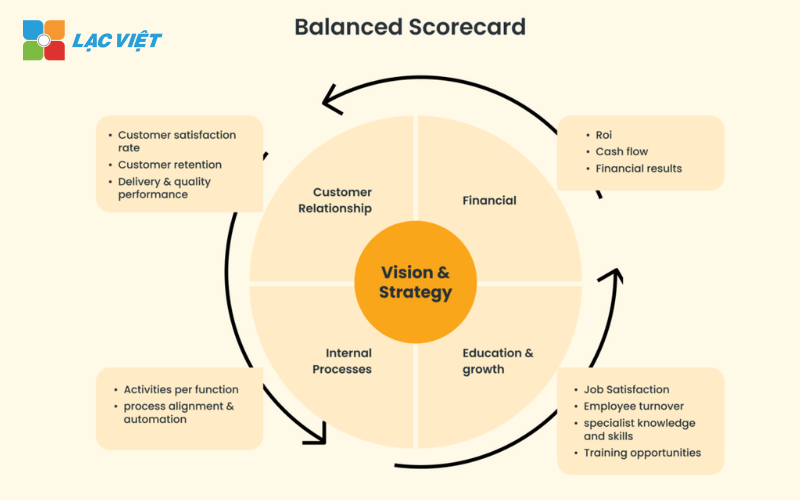
Advantages:
- Comprehensive measurement of job performance based on the four main aspects.
- Help organizations link the strategic objectives with day to day activities.
- Help the organization focus on the important goals to long-term development direction.
Cons:
- The process of establishing, implementing the BSC can be complex, costly.
- The identification of indicators to measure suit for each aspect may be difficult.
- For successful implementation, the BSC needs to have the commitment and positive support from the management level.
3.4 qualitative Methods (360-degree Feedback)
Method 360-degree Feedback is a process of comprehensive review, collect feedback from multiple stakeholders such as managers, colleagues, subordinates, and even customers. Employees not only get reviews from superiors but also have a comprehensive view from different angles in the work environment. Implementation process include:
- Identify sources of feedback, select the objects that will participate in the evaluation process.
- Collect feedback: Use tools such as surveys and interviews to collect comments from the selected objects.
- Data analysis: synthesis, analysis of feedback to make a good overview of the performance of employees.
- Provide feedback to staff: Share assessment results with the employee to discuss the measures to improve.
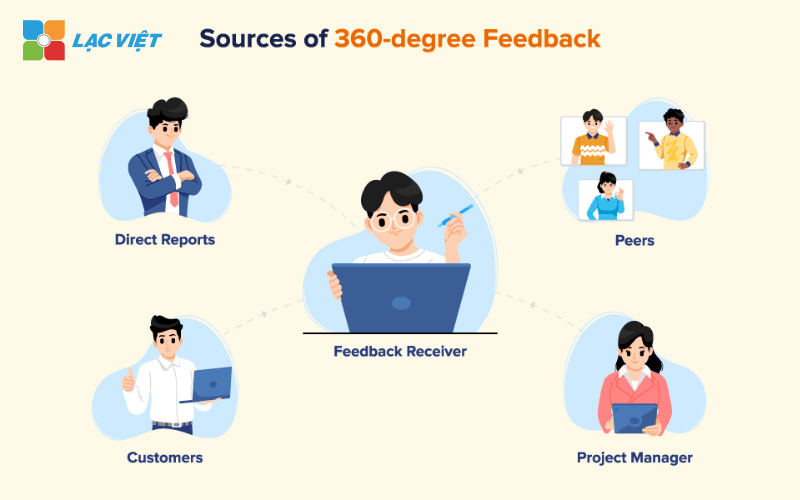
Advantages:
- Provides information from many sources to help evaluate accurate, more complete understanding of the performance of employees.
- Detect the skills yet to be seen as soft skills, work attitude, which other methods can be ignored.
- Employees have the opportunity to recognize the strengths and weaknesses of yourself from different angles.
Cons:
- Expensive, complex: the process of collecting and analyzing data from multiple sources can be time-consuming, the human cost of implementation.
- Feedback from multiple sources can be conflicting, which leads to misunderstanding, conflict.
- Depends on the objective of the assessment, if the assessment lack of objectivity, the results may be biased.
Practical application: The Google group has developed methods 360-degree feedback as an integral part in the rating system work efficiency. After applying this method, the company noted the improvement of teamwork, ability to communicate internally, with the level of satisfaction of employees increased by 13% compared to the previous.
3.5 Methods of BARS (Behaviorally Anchored Rating Scales)
BARS (Behaviorally Anchored Rating Scales) method is evaluated based on a scale is associated with the specific behavior of employees in the implementation process of the work. Instead of just rating based on the final result, this method attention to how employees achieve that result. Specific behavior will be described and tied to the corresponding points, thereby creating a basis for comparison, evaluate the effectiveness of the work.
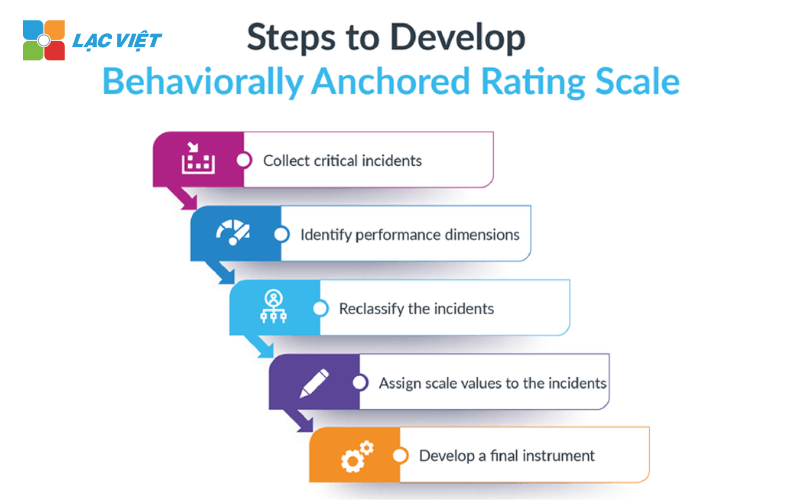
Implementation process include:
- Determine the critical behavior for work.
- Set scale assessment based on the behavior defined, from the level of the poor to the level of excellence.
- Collect assessment: Use this scale to assess the job performance of employees based on the actual behavior.
- Provides feedback to employees based on evaluation results and propose improvement measures.
Advantages:
- BARS provide the criteria for evaluating specific and objective based on the actual behavior.
- Staff can identify the behaviors that need improvement, focus on developing the necessary skills.
- Evaluation results based on clear criteria, help to enhance transparency, ensure fairness.
Cons:
- The process of identifying, describing the critical behavior can be time-consuming effort.
- BARS may not be suitable for tasks that require creativity and flexibility.
Practical application: Company ExxonMobil method used BARS to rate employees according to the behavior related to project management and occupational safety. They have built the scale score based on the critical behavior, such as how decision-making, communication, and compliance processes. After applying the BARS, the level of occupational safety in the project of ExxonMobil has increased markedly.
Here are 5 methods that are commonly used in many businesses, however methods this review stop at just evaluate the work of 1 individual or group 1, not shown to be effective work of the organization as application work groups. Effective work of the organization also expressed in the continuity and consistency between departments to create value in the end.
To be able to measurable performance, it does not need to have a system business processmade of chemical to be able to measure the performance of each step as well as measure the effectiveness of all operational processes.
A number of related information to better understand digitized, standardized operating procedures:
- Digitized workflow solutions and standardize workflows
- Standardized operation process, what is? Why standardization?
- Build workflow company, with 6 steps STREAMLINED with process template
4. Use LV-DX Dynamic Workflow system, the whole operation to monitor, evaluate work performance, visual
LV-DX Dynamic Workflow can help a business evaluate the performance commissioning comprehensive how?
- Digitizing the entire process, every activity and every work can track, monitor progress closely
- Every business process from processes internal to the workflow between departments are connected to measure the performance of the employees.
- The responsibility of the individual parts are defined, recorded on the software to evaluate the performance clearly.
- Interface reports, performance reviews, with more tabular, chart data.

In addition, the use of LV-DX Dynamic Workflow will help businesses simplify the implementation of number conversion made conversion of fast business activity to be effective, optimum cost after conversion.
- The entire process of business are standardized for free upon request, structural characteristics of the business when the sign up purchase the software.
- Set workflow automatically transferred in the process.
- Integrated support chatbot WHO helps leaders checking the data on the file browser in the process. Made to approve, register number quickly, eliminating the time the report.
Contact us Vietnam to sign up free demo software Workflow to reviews the work efficiency operation of the business only on a system, affecting only.
CONTACT INFORMATION:
- Lac Viet Computing Corporation
- Hotline: 0901 555 063 | (+84.28) 3842 3333
- Email: info@lacviet.vn – Website: https://lacviet.vn
- Headquarters: 23 Nguyen Thi Huynh, P. 8, Q. Phu Nhuan, Ho Chi Minh city





